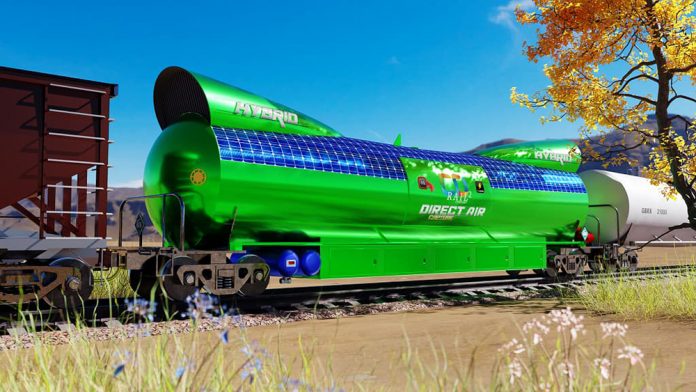Railways could help counter climate change and remove CO2 from the air by capturing the sustainable energy generated when trains brake and decelerate.
US start-up CO2Rail Company has been working with a global team of researchers, including engineers from the University of Sheffield, to design Direct Air Capture (DAC), a technology to remove carbon dioxide from the air via special carriages on existing trains.
The system works by using the large intakes of air that extend up into the slipstream of the moving train to move ambient air into a large cylindrical CO2 collection chamber.
A chemical process separates the CO2 from the air and the carbon dioxide-free air travels out of the back or underside of the car and returns to the atmosphere.
When a sufficient amount is captured, the chamber is closed and the harvested CO2 is collected, concentrated, and stored in a liquid reservoir until it can be emptied from the train into normal CO2 rail tank cars. It is then transported into the circular carbon economy as feedstock or to geological landfill sites.
These processes are powered by on-board generated, sustainable energy sources that require no external energy input or off-duty charging cycles.
When a train pumps the brakes, its energy braking system converts the train’s forward momentum into electrical energy in a similar way to a regenerative electric vehicle. Currently, this energy dissipates in the form of heat and is discharged out of the top of the vehicle during every braking manoeuvre.
Research co-author, Professor Peter Styring from the University of Sheffield and Director of the UK Centre for Carbon Dioxide Utilisation, explained: “Currently the enormous amount of sustainable energy created when a train brakes or decelerates is simply lost.
“The technology will harvest meaningful quantities of CO2 at far lower costs and has the potential to reach annual productivity of 0.45 gigatons by 2030, 2.9 gigatons by 2050, and 7.8 gigatons by 2075 with each car having an annual capacity of 3,000 tonnes of CO2 in the near term.”
Unlike stationary DAC operations, which require large areas to build equipment and construct renewable sources of energy to power them, CO2Rail would be transient and generally unseen by the public.
Eric Bachman of CO2Rail Company said: “On average, each complete braking manoeuvre generates enough energy to power 20 average homes for an entire day, so it is not a trivial amount of energy.
“Multiply this by every stop or deceleration for nearly every train in the world and you have about 105 times more energy than the Hoover Dam produces within that same period, and that was a hydro-electric construction project that took six years and cost $760 million in today’s dollars.”
He added: “Imagine stepping onto a train each morning, seeing the CO2Rail cars attached, and knowing that your commute to work each day is actually helping to mitigate climate change.
“It will work the same with freight, if there is a choice between rail and another mode of transportation, I think this technology will sway many shippers.”
The team found each direct air capture car can harvest about 6,000 metric tons of carbon dioxide from the air per year – and more as the technology develops. Since trains are capable of hosting multiple CO2Rail cars, each train will harvest a corresponding multiple of CO2 tonnage.
This, along with other significant savings, such as land, brings projected cost at scale down to less than $50 per tonne and makes the technology not only commercially viable but commercially attractive.
The team is also working on a similar system to remove CO2 emissions from the exhausts of diesel-powered locomotives which are still common around the world.
The research “Rail-Based Direct Air Carbon Capture” is published in the Future Energy section of the journal Joule.



